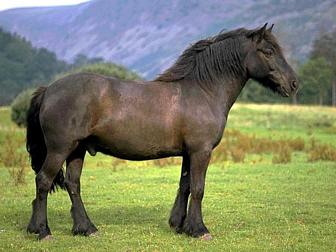
OVERVIEW
There is a demand for an all-round family pony capable of carrying all members of the family and versatile enough to fulfil a wide variety of jobs previously done by two or three more specialised animals. In this capacity the Fell pony is ideal being well up to the weight of a heavy adult. Their size still makes them suitable for experienced children, with many having the right temperament for younger children. In many respects the present day family Fell pony is mainly continuing to apply to modern demands, the same adaptability which endeared it to the Lakeland farmers of approximately a hundred years ago.
As a hack and general riding pony, the Fell's fast walk and easy paces make it a pleasant and comfortable ride, and its sure footedness ensures a safe passage over the roughest country. It is possible to ride a Fell pony through places where other lighter bred ponies would come to grief and Fells seem to have a sixth sense which alerts them to possible danger, they seem to know which is the soundest track through soft marshy ground or the safest descent of a rocky hillside.
PHYSICAL DESCRIPTION
The Fell Pony is usually black, due, in part, to its Friesian influence, but also appears occasionally in bay, brown, or gray. Standing around 14 hands high, the Fell is slightly smaller than its close neighbor, the Dales. It has a pony type head, alert with short, pricked ears. The body is thick and muscular with strong loins and sloping hindquarters. It has a better riding shoulder than the Dales, making it, when crossed with the Thoroughbred, an excellent hunter. The legs have good bone and are marked by feathering at the heels. The hooves are large and of very hard blue horn. The mane and tail are thick and bushy.
ORIGIN
The Wild European pony is thought to have migrated to the British Isles approx 15,000BC. One type predominated in northern England, and can be credited as the progenitor of the Fell pony. When crop farming and animal husbandry replaced hunting, wild ponies were drastically reduced to conserve available pasture. In northern England ponies became almost extinct in some parts and those that remained existed in small pockets which encouraged inbreeding and so led to regional characteristics.
By the time the Romans were well established in the North there must have been a definite type of dark coloured pony, standing perhaps just over 13 hands, bred within the local catchment area of Hadrian's Roman Wall. During the Roman occupation on the border between England and Scotland, auxiliary troops were brought in from other countries to help man Hardian's Wall, which separated these two countries. These auxiliaries would have brought along their own war stallions, many of these were probably left behind to breed and produce a mixture of types in northern England.
A cross between these French, Fresian, German, Polish, or Spanish horses and the Celtic pony is believed to have helped shape many British native pony breeds, including the Fell (79AD to approx. 420AD).
INTERESTING FACTS
The early fell pony type of animal made an ideal working animal, it was strong and sure-footed, placid in nature and not too big to make loading and unloading difficult while being up to the weight of a full load. Unlike the small native ponies of pre-Roman times, the improved Fell type was large enough for a man to ride and was recognised as a dual-purpose breed.
The Vikings used the ponies for ploughing and sledge pulling, the Normans for shepherding, by the thirteenth century there was a brisk trade in wool to Belgium, and local ponies were used to transport merchandise around the country, old packways can still be seen today.
Fell ponies were used to transport slate, copper, and lead as well as iron ore and may well have done so since Roman Times. The advent of the Industrial Revolution was a comparatively rapid innovation but one that, directly or otherwise, affected the whole country. Its initial effect on the Fell pony came by way of iron-ore mines situated in the north-west of England. Once excavated the ore had to be transported across country to the smelting works of the north-east coast, and because of the uneven topography of the country and complete lack of suitable roads and canals, other feasible methods of transport had to be found. The coming of the railways meant redundancy for many of the pony teams and their dependant tradesmen, within an incredibly short period of time hundreds of ponies disappeared, many being sold abroad for slaughter. Fortunately the Fell pony was still surviving in its native Lakeland home, and despite its dramatic rise and fall at the hands of the industrialists, as a breed it was quite unchanged, for the disbanding of pony teams had not affected the true pony breeding stock at home on the Cumbrian hills.
Information obtained from the Fell Pony Society website
INFLUENCES
1. Celtic Pony
2. Galloway
3. Friesian
For more information:
Fell Pony Society
Listed as "Rare" by The American Livestock Breeds Conservancy (2004)